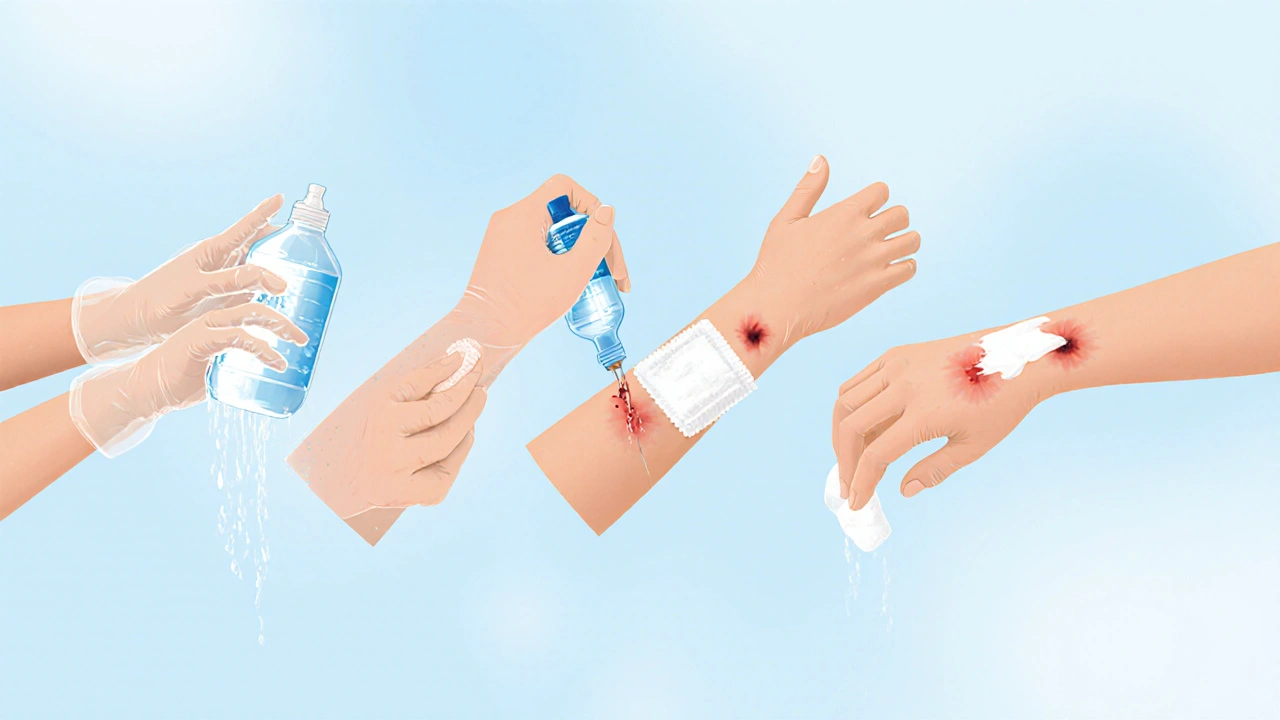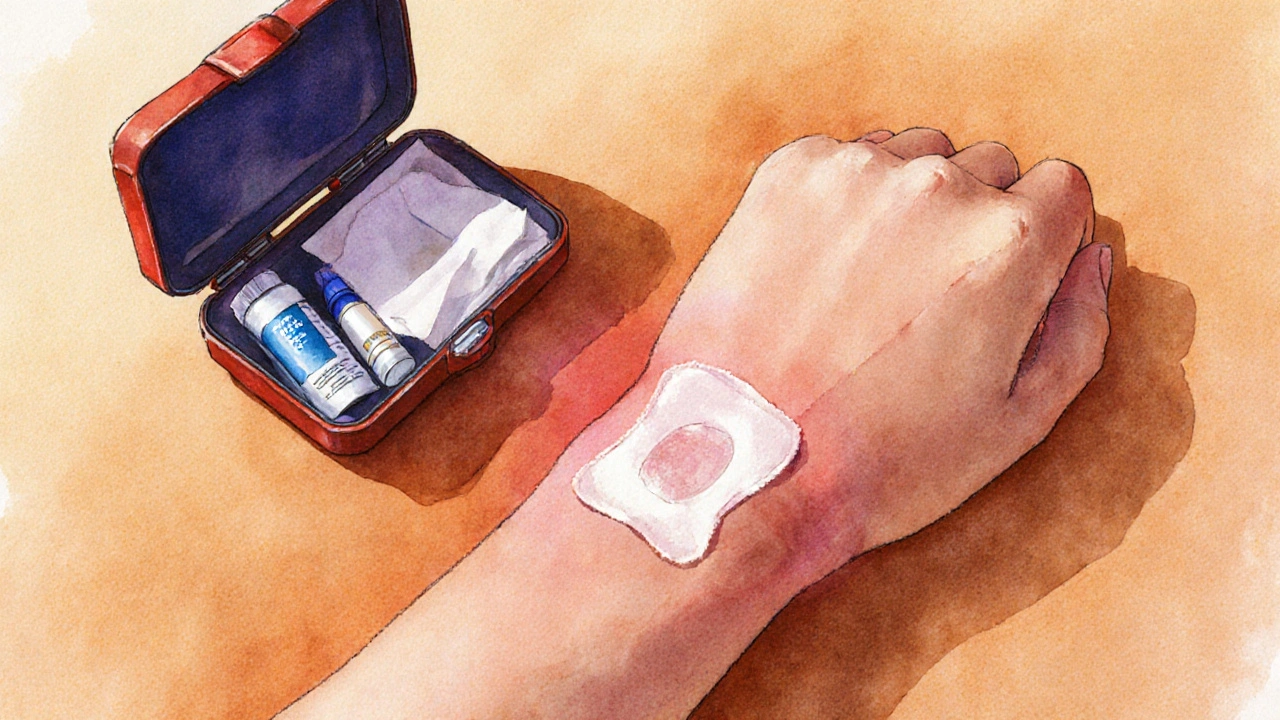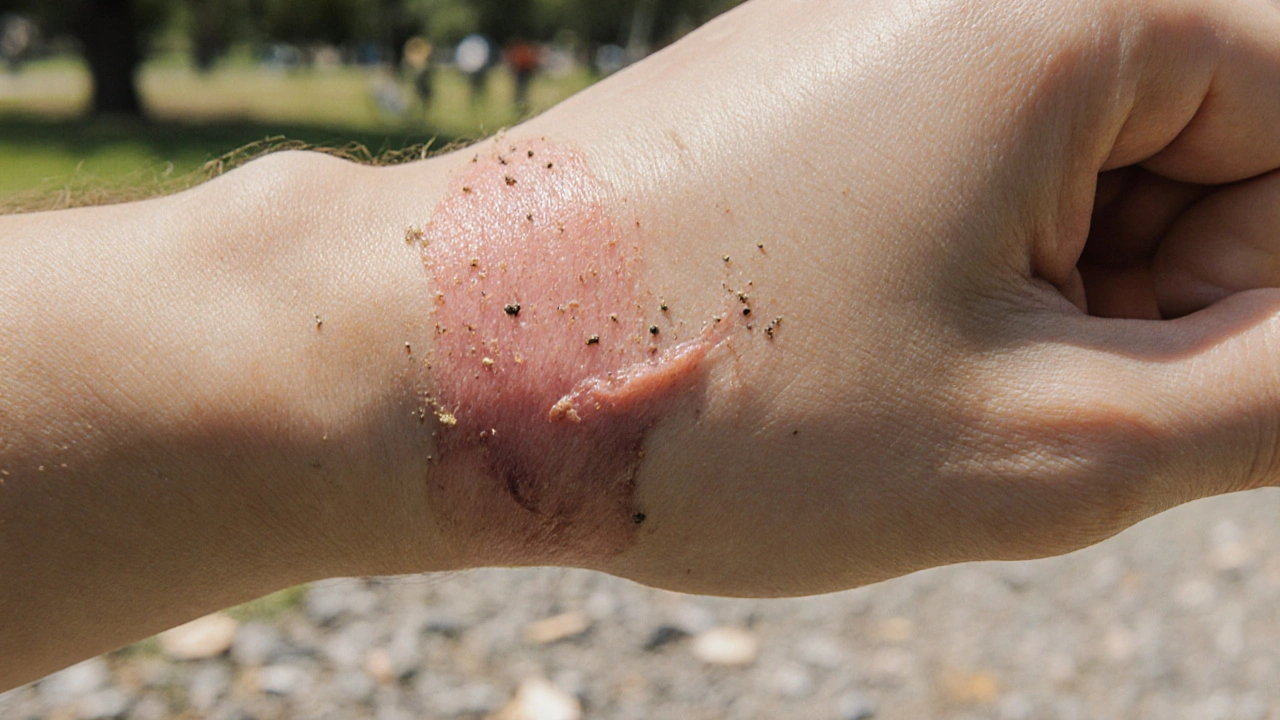Abrasions Care Step-by-Step Guide
Understanding Abrasions
An abrasion is a superficial wound that scrapes away the epidermis, often exposing the dermis. These wounds commonly occur from falls, bike accidents, or rough play.
Essential Supplies Checklist
- 1 Sterile saline solution
- 2 Mild antiseptic (povidone-iodine or chlorhexidine)
- 3 Sterile gauze pads
- 4 Antibiotic ointment (bacitracin or mupirocin)
- 5 Non-stick dressing
- 6 Medical gloves
Cleaning Steps
Wash Hands
Use soap and warm water for at least 20 seconds, then put on gloves.
Stop Bleeding
Apply gentle pressure with a clean gauze pad for a minute or two.
Rinse with Saline
Pour sterile saline over the wound or soak a gauze pad and dab gently.
Disinfect
Apply a thin layer of mild antiseptic to deeper abrasions.
Pat Dry
Use a fresh sterile gauze pad to blot, not rub, the area.
Apply Ointment
Spread a thin layer over the entire wound to create a bacterial barrier.
Cover Dressing
Place a non-stick pad then secure with medical tape.
Schedule Changes
Replace the dressing once a day or when it becomes wet or dirty.
Antiseptic Comparison
| Antiseptic | Pros | Cons | Best Use Case |
|---|---|---|---|
| Saline (0.9% NaCl) | Gentle, no cytotoxicity | Does not kill bacteria | Initial rinse and shallow wounds |
| Povidone-iodine (5%) | Broad-spectrum antimicrobial | Can stain skin, may irritate | Deeper abrasions needing strong disinfection |
| Chlorhexidine gluconate (2%) | Long-lasting activity, low irritation | Not for patients with iodine allergy | Patients with sensitive skin |
| Hydrogen peroxide (3%) | Effervescent cleaning action | Damages fibroblasts, slows healing | Only for initial debris removal |
After-Care Tips
- Apply antibiotic ointment daily
- Use breathable film dressing for waterproof protection
- Try hydrocolloid pads for larger areas
- Avoid cotton balls or fluffy gauze that can stick
- Protect from friction during activities
Infection Warning Signs
- Redness spreading beyond the wound edge
- Swelling that feels warm to the touch
- Pus or foul odor
- Fever above 38°C (100.4°F)
- Increasing pain after 48 hours despite dressing changes
Tetanus Prevention
If the abrasion was caused by a dirty object and your last tetanus booster was over five years ago, get a booster shot.
Note: For puncture wounds, consider a booster if your last one was over three years ago.
Quick Recap
Proper abrasion care involves:
- Washing hands thoroughly before treatment
- Using sterile saline to rinse the wound
- Applying antibiotic ointment to prevent infection
- Covering with a non-stick dressing
- Changing the dressing daily
- Monitoring for signs of infection
Tip: A moist environment promotes faster healing compared to leaving the wound exposed to air.
Quick Summary
- Identify the abrasion and assess depth.
- Gather sterile saline, mild antiseptic, clean gauze, and antibiotic ointment.
- Rinse gently, disinfect, apply ointment, and cover with a non‑stick dressing.
- Change dressing daily, keep the area moist, and watch for infection signs.
- Seek medical help if redness spreads, fever develops, or the wound won’t heal.
When you scrape your skin, the instinct is to wipe it off and move on. But a careless rinse or the wrong ointment can turn a minor Abrasion is a superficial wound that removes the top layer of skin, exposing the underlying tissue into a painful infection. This guide walks you through the exact steps to clean, protect, and monitor an abrasion so it heals fast and stays infection‑free.
What Exactly Is an Abrasion?
An abrasion is a wound that scrapes away the epidermis, often exposing the dermis. Unlike cuts, abrasions usually have irregular edges and collect debris like dirt or gravel. Most are caused by falls, bike accidents, or rough play. While many abrasions are shallow and heal in days, deeper ones can lose the protective skin barrier, making infection more likely.
Gather the Right Supplies
Before you start cleaning, set up a small wound‑care kit. Having everything ready avoids contamination and saves time.
- Sterile saline solution - a gentle, isotonic fluid for rinsing.
- Mild antiseptic such as povidone‑iodine or chlorhexidine.
- Sterile gauze pads - non‑woven and lint‑free.
- Antibiotic ointment (e.g., bacitracin or mupirocin).
- Non‑stick dressing - a breathable film or hydrocolloid pad.
- Medical gloves - to keep your hands clean.
- Scissors (if you need to trim tape).
If you’re unsure about any product, a basic wound care kit sold at pharmacies usually includes all these items.

Step‑by‑Step Cleaning Process
- Wash your hands. Use soap and warm water for at least 20 seconds, then put on gloves.
- Stop the bleeding. Apply gentle pressure with a clean gauze pad for a minute or two. Most abrasions stop bleeding quickly.
- Rinse with saline. Pour sterile saline over the wound or soak a gauze pad and dab gently. This flushes out dirt, sand, and dead skin cells without damaging new tissue.
- Disinfect. If the abrasion is deeper than 2mm, apply a thin layer of a mild antiseptic. Avoid hydrogen peroxide in large amounts; it can delay healing by harming fibroblasts.
- Pat dry. Use a fresh sterile gauze pad to blot, not rub, the area.
- Apply antibiotic ointment. Spread a thin layer over the entire wound. This creates a barrier against bacteria and keeps the tissue moist.
- Cover with a dressing. Place a non‑stick pad then secure with medical tape. The dressing should be breathable but waterproof enough to keep out contaminants.
- Schedule dressing changes. Replace the dressing once a day or when it becomes wet or dirty. Re‑apply ointment each time.
Following these eight steps reduces the chance of infection and speeds up the healing timeline from a week to just three-four days for shallow abrasions.
Choosing the Right Antiseptic - Quick Comparison
| Antiseptic | Pros | Cons | Best Use Case |
|---|---|---|---|
| Saline (0.9% NaCl) | Gentle, no cytotoxicity | Does not kill bacteria | Initial rinse and for shallow wounds |
| Povidone‑iodine (5%) | Broad‑spectrum antimicrobial | Can stain skin, may irritate | Deeper abrasions needing strong disinfection |
| Chlorhexidine gluconate (2%) | Long‑lasting activity, low irritation | Not for patients with iodine allergy | Patients with sensitive skin |
| Hydrogen peroxide (3%) | Effervescent cleaning action | Damages fibroblasts, slows healing | Only for initial debris removal, then stop |
For most everyday scrapes, start with saline and finish with a mild antiseptic like chlorhexidine. Reserve povidone‑iodine for heavily contaminated wounds.
Dressing and After‑Care Tips
Keeping the wound moist is key. A dry scab can crack, reopening the abrasion. Here’s how to maintain the right environment:
- Apply a thin layer of antibiotic ointment each time you change the dressing.
- Use a breathable film dressing (e.g., Tegaderm) for mild abrasions that need a waterproof seal.
- For larger areas, try a hydrocolloid pad; it absorbs fluid while keeping the surface moist.
- Avoid cotton balls or fluffy gauze that can stick to the wound.
When you’re back to normal activities, protect the site from friction. Over‑the‑counter padding or a simple silicone sleeve can prevent the abrasion from reopening.
Watch for Infection - When to Call a Professional
Even with perfect care, infections happen. Early detection prevents complications.
- Redness spreading beyond the wound edge.
- Swelling that feels warm to the touch.
- Pus or foul odor.
- Fever above 38°C (100.4°F).
- Increasing pain after 48hours despite dressing changes.
If any of these signs appear, seek medical attention promptly. A doctor may prescribe oral antibiotics or, in rare cases, need to debride the wound.
Don’t forget about tetanus. If the abrasion was caused by a dirty object and your last tetanus booster was over five years ago, get a booster shot.

Frequently Asked Questions
How long does an abrasion usually take to heal?
Shallow abrasions often close in 3‑5 days, while deeper ones may need up to two weeks. Keeping the wound moist and protected can shave a day or two off the timeline.
Can I use bottled water to rinse an abrasion?
It’s better to use sterile saline or clean tap water boiled and cooled. Bottled water isn’t guaranteed sterile and may introduce microbes.
Is hydrogen peroxide ever okay for an abrasion?
A quick splash can help remove visible debris, but you should stop using it after the first rinse. Continued use harms the cells needed for healing.
Do I need a tetanus shot for a minor scrape?
If the wound was caused by a dirty object and your last booster was more than five years ago (or three years for a puncture), a booster is recommended.
Can I expose the abrasion to air instead of covering it?
Modern wound care research shows that a moist environment heals faster. Leaving it open can dry out the tissue and increase scarring.
Proper abrasion care isn’t complicated-you just need the right steps, clean supplies, and a watchful eye for infection. Follow this guide, and most scrapes will heal cleanly, pain‑free, and with minimal scarring.

All Comments
Emily Collier October 2, 2025
Maintaining a moist wound environment is not just a trendy recommendation; it’s backed by decades of research showing faster re‑epithelialization and reduced scarring. After you’ve cleaned the abrasion, apply a thin layer of antibiotic ointment and cover it with a non‑stick, breathable dressing. This creates a semi‑occlusive seal that keeps pathogens out while allowing oxygen diffusion, which fibroblasts need for collagen synthesis. Changing the dressing once a day, or sooner if it becomes saturated, ensures the wound stays clean without drying out. Remember to monitor for redness spreading beyond the margin, increased warmth, or pus-early signs that the infection barrier has been breached.
M2lifestyle Prem nagar October 13, 2025
Grab saline, gauze, and ointment; rinse, dab, and cover-repeat daily.
Karen Ballard October 24, 2025
Great guide, very clear! 👍
Gina Lola November 4, 2025
When you get a scrape you’re basically dealing with a breach in the skin’s barrier function, and that triggers an amazing cascade of cellular events. First the clotting cascade forms a provisional matrix that stops the bleeding, then inflammatory cells swarm the area to clean up debris. If you jump straight to a harsh antiseptic like hydrogen peroxide, you’ll wipe out not only the bacteria but also the beneficial neutrophils and fibroblasts that are essential for repair. That’s why the guide’s emphasis on sterile saline is spot on-it rinses away particulates without cytotoxicity. After the rinse, a mild antiseptic such as chlorhexidine can be applied to keep the microbial load low while preserving viable tissue. The next step, applying a thin film of antibiotic ointment, creates a moist micro‑environment that encourages keratinocyte migration. Dry scabs tend to crack, reopening the wound and prolonging inflammation, so keeping it moist is key. The non‑stick dressing acts like a semi‑permeable membrane, allowing gas exchange but blocking external contaminants. Changing the dressing daily is a practical balance: you refresh the antimicrobial layer without constantly disturbing the new tissue. If you notice any erythema spreading beyond the edges, that’s a red flag for infection and you should seek professional care. Also, keep an eye on systemic signs like fever, because a localized infection can quickly become systemic. The tetanus point is often overlooked; a dirty abrasion in a person whose booster is overdue is a perfect scenario for a booster dose. Finally, the guide’s quick recap is gold for anyone who needs a mental checklist when under pressure. In summary, rinse with saline, apply a mild antiseptic, keep it moist with ointment, protect with a breathable dressing, and watch for infection-simple, effective, and evidence‑based.
Leah Hawthorne November 15, 2025
That long breakdown really puts the whole process into perspective-especially the part about avoiding harsh chemicals early on. I’ve seen people ruin a good healing window by over‑scrubbing with iodine, which can be irritating. The suggestion to stick with saline first is solid, and the reminder about keeping the dressing breathable but waterproof hits the sweet spot for active folks. Also, the infection‑watch checklist is a lifesaver; catching a spreading redness early can prevent a whole lot of trouble. Thanks for the thorough recap!
Brian Mavigliano November 26, 2025
Honestly, the whole “keep it moist” mantra feels like a marketing ploy. In my experience, letting a scrape air out forms a natural scab that protects the wound from external microbes. Over‑dressing can trap bacteria and actually increase infection risk. Sometimes the simplest approach-clean with water, let it dry, and keep an eye on it-works better than a whole arsenal of ointments and dressings.
Emily Torbert December 6, 2025
i get where you're coming from but i think the moist method works for most people especially if you want less scarring and faster healing i have tried both and the ointment + dressing combo gave me a smoother result
Rashi Shetty December 17, 2025
While the practical steps are sound, one must also consider the moral responsibility of proper wound care. Neglecting sanitation not only endangers the individual but also places a burden on public health resources. It is incumbent upon each of us to follow evidence‑based protocols and avoid complacency. Moreover, the emphasis on sterile saline reflects a commitment to scientific rigor that should be upheld universally. Let us not trivialize the importance of timely tetanus boosters, especially in regions where access to medical care is limited. In short, diligent care is an ethical imperative as well as a medical one. 🌟